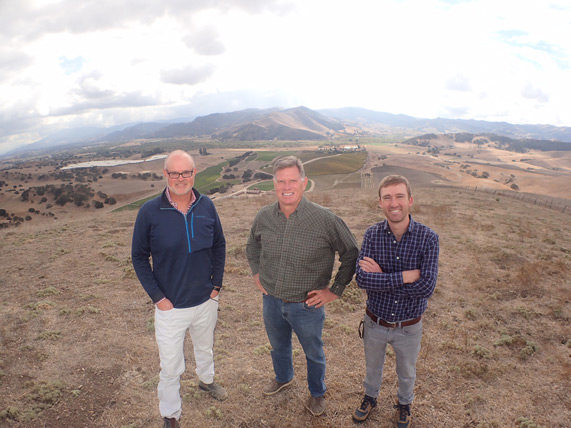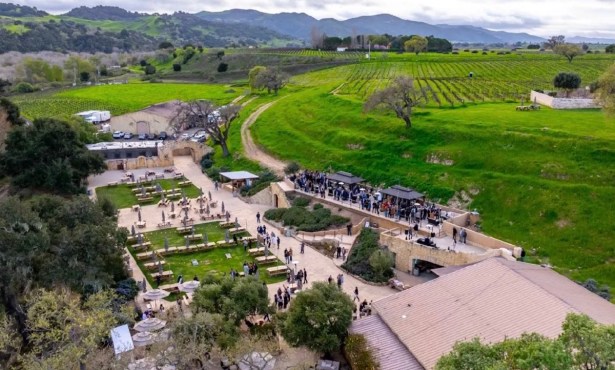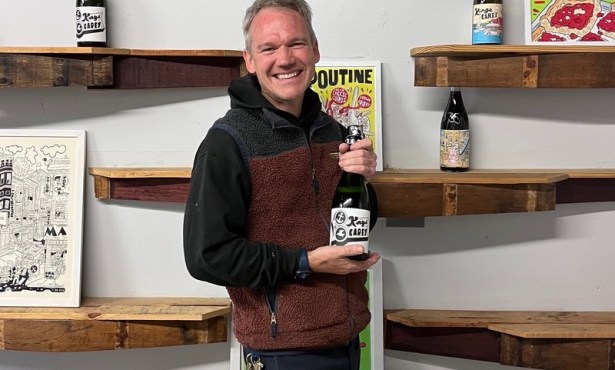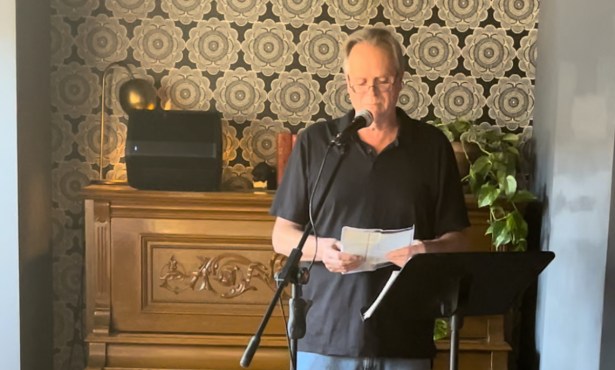Pence Vineyards Proves a Point
Blair Pence’s Team Is Making the Sta. Rita Hills’ Most Exciting Wine

“This is really like old California out here,” says Blair Pence, driving an off-roader up through the hills on the back of his 200-plus-acre ranch off Highway 246, where a 1907 homestead is headquarters to Pence Vineyards & Winery. He’s mostly right — aside from some cannabis hoop houses in a neighboring canyon, this part of the two-mile-long ranch doesn’t have much more than oak trees, sagebrush, and the occasional steer chewing on dry grass, one of the 30 head of Black Angus he raises.
Like an old California rancho, Pence is diversifying the land, albeit with contemporary tastes and organic methods. Alongside 44 acres of grapevines, which sit on the eastern edge of the Sta. Rita Hills, the Bakersfield-raised, USC-educated, 59-year-old commercial real estate developer is growing 12 types of olive trees from six different countries as well as marcona almonds, hay for cattle, rye for bread, vegetables for restaurants, chickens for eggs, and pesky peacocks for, well, no one remembers why. There’s also an extensive equestrian center with two trainers and 40 horses — six of which are his, as cutting horses were the passion that originally lured him to Los Olivos from Los Angeles in 1999.
“We’re about 90 percent self-sufficient,” explained Pence, who employs a full-time farming staff of 10, led by Francisco Ramirez and Daniel Garibay. “People like that. It allows precision.”
Along for the ride are winemaker John Faulkner (a disciple of renowned vintner Sashi Moorman) and general manager Stephen Janes, who worked at Melville Winery for the 10 years prior. We’ve already cruised through the vines on the property’s lower mesa — primarily pinot noir in the clay soils and chardonnay in the calcareous, limestone-like dirt. Atop the peak, as a tarantula wandered by in search of a mate, Pence explained, “Our plan is to do syrah up here.”
Planting syrah in pinot noir country doesn’t qualify as all that vanguard, but much of this operation certainly does. After buying the ranch in 2005, Pence was the first to plant vines according to a special mapping technique that aligned soil makeup to sun exposure, thereby ensuring more even ripening. They’ve put in an extremely tight and steep syrah vineyard overlooking the old ranch homes, with 7,000 own-rooted vines per acre, hung from the A-frame trellising used in Côte-Rôtie. They have also planted about three acres of grenache, have a half-acre of aligoté going in, and have already swapped out some pinot vines for gamay noir from Oregon. That’s being turned into the “PTG” blend of pinot and gamay as well as a gamay nouveau, which is bottled without sulfur, released just months after harvest, and only $18.
“Our plan is to keep planting right up the hill,” said Pence, but he never expects to approach the 120 acres of vineyard that the property could support. He’s particularly proud of the water that irrigates the crops, which hasn’t diminished since he drilled the well. “The water is crystal clear — we drink it right from the tap,” said Pence. “If you think about what’s in a grape ….” Janes jumped in. “It’s 81 percent water!” Perhaps water quality plays a much bigger role in resulting wines than we’ve ever properly considered.
Pence first made headlines by pushing to expand the Sta. Rita Hills AVA, or American Viticultural Area, eastward to include his ranch. Vocal critics, many of whom had created the appellation in 2001, cast him as a carpetbagger scheming to disregard their earlier studies and artificially inflate the price of his fruit. So Pence hired a scientist to show that the climate, soils, and other defining viticultural characteristics were close enough to warrant inclusion. Despite the loud opposition, the feds approved the expansion in 2016, and today, Pence uses almost all of his fruit anyway, only selling a bit to Drake Whitcraft. The controversy slowly simmered down.
Pence’s name also made the press tragically in 2014, when his life partner and winery cofounder, Holly Eve Brooks, died in an ATV roll-over. He’s since found solace in Dianne Baker, and they married in September 2017. Among other attributes, Dianne is a wonderful cook, as evidenced by our excellent lunch that afternoon.
Altogether, life on the ranch appears to be settling into a groove, save for an errant peacock or three. Pence hopes to break ground for an on-site winery in spring 2019, and visitors can come to taste the wines by appointment, which involves a pleasant couple of hours sitting around the pond, under a gazebo, or inside the refashioned barn.
It’s possible that these grapes, if not treated with the current levels of meticulous care in both the vineyard and cellar, could result in the sort of overripe, non-coastal wines that critics of the appellation expansion feared. But as it stands now, Pence Ranch is making some of the best and most exciting wine in the entirety of the Sta. Rita Hills.
“We’re all quite proud of these wines,” said Faulkner as we tasted through the latest lineup. “They’re really reflective of the ranch, of all of the farming, of all of the winemaking.”
Added Janes, without skipping a beat, “They overdeliver.”
See pencevineyards.com.



